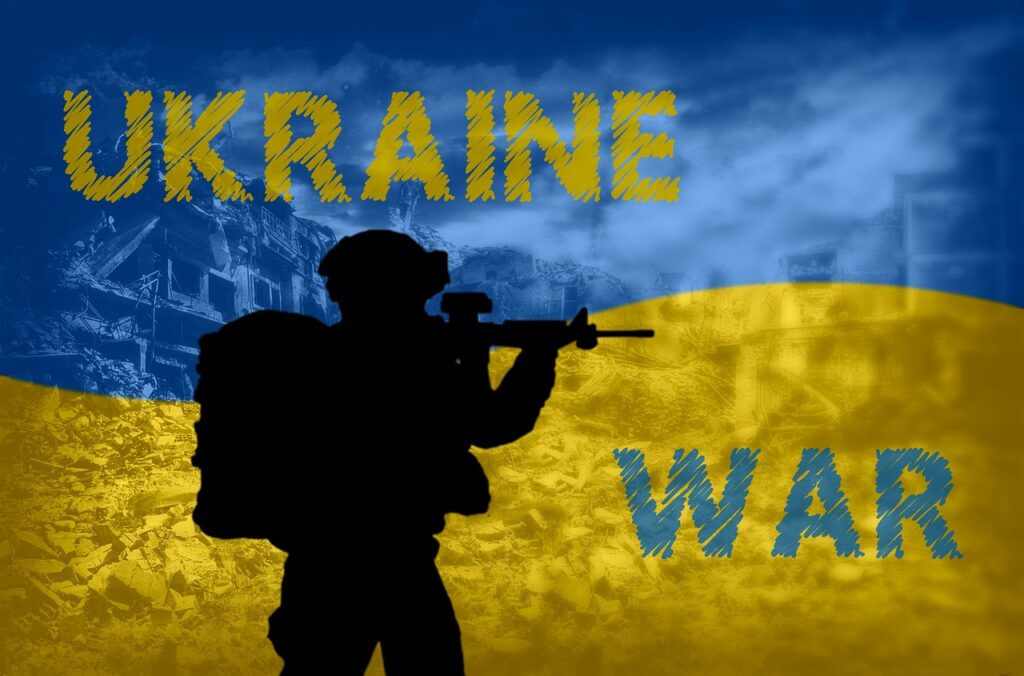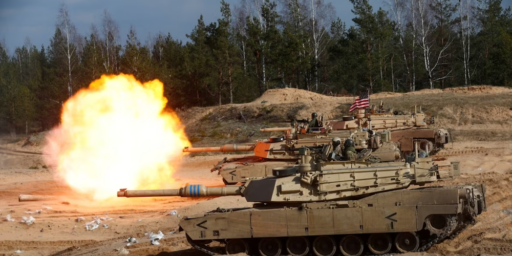Ukraine and the ‘New Rules of War’
Many and small beats large and heavy. Finding beats flanking. Swarming beats surging.

Today’s column by Tom Friedman, “Free Advice for Putin: ‘Make Peace, You Fool’,” is insightful because, instead of relying on a conversation with a taxi driver, it instead relies on one with “one of America’s premier teachers of grand strategy, John Arquilla, who recently retired as a distinguished professor of defense analysis at the U.S. Naval Postgraduate School.”
I’ve referenced Arquilla a handful of times going back to the earliest days of the blog and even interviewed him (along with Dave Schuler) on the late, lamented OTB Radio* show back in 2010. His insights on the evolution of warfare, and especially the impact of information, have been quite prescient and predicted many of the trends that have contributed to Russia’s embarrassingly poor showing against a much smaller force in Ukraine.
“In many respects, this war is our era’s Spanish Civil War. In that war, many weapons — like Stuka dive bombers and Panzer tanks — were tested out by the Germans, and the allies learned things as well, before World War II. The same is being done in Ukraine when it comes to next-generation warfare.”
Arquilla recently published a book on next-gen warfare, “Bitskrieg: The New Challenge of Cyberwarfare.”
“In that book, I outlined the three new rules of war, all of which I am seeing being employed by the Ukrainians,” he explained. “The first is that many and small beats large and heavy. The Ukrainians are operating in squad-level units armed with smart weapons, and these are able to disrupt far larger formations and attack slow-moving, loud helicopters and such. So even though they’re outnumbered by the Russians, the Ukrainians have many, many more units of action — usually between eight and 10 soldiers in size.”
Arquilla said that these small Ukrainian units armed with precision-guided smart weapons like killer drones, antiaircraft weapons and light anti-tank weapons “can take out the Russians’ much larger and more heavily armed tank units.”
The second rule of modern warfare playing out in Ukraine, he said, “is that finding always beats flanking. If you can locate the enemy first, you can take him out. And especially if the enemy is made up of a few large units, like a 40-mile-long convoy of tanks and armored personnel carriers, you’re going to hammer the hell out of them with your small squads, without having to outflank them with an equal-sized force.”
I asked Arquilla why the Ukrainians are so good at finding. (I assume they are getting some reconnaissance help from NATO.)
“The Ukrainians are making very good use of small drones, particularly those Turkish drones, which are tremendous,” said Arquilla. But it’s their human sensors — the informal Ukrainian observer corps — that are devastating the Russians. Grandmas with iPhones can trump satellites.
“The Ukrainian observer corps is made up of babushkas and kids and anyone else who has got a smartphone,” he said. “And they’ve been calling in the locations of where the Russian units are and where they’re moving. And so the Ukrainian forces have this big edge in finding the Russians in this big country, and that is giving their small units with smart weapons” real-time, actionable intelligence.
The third rule of new-age warfare playing out in Ukraine, said Arquilla, is that “swarming always beats surging.” He explained: “War is not just a numbers game anymore. You don’t need big numbers to swarm the opponent with a lot of small smart weapons. I am sure you’ve seen some of the videos of these Russian tanks and columns, where suddenly one tank gets taken out at the front and then another at the rear, so the Russians can’t maneuver, and then they just get picked off.”
He’s been making some of these arguments going back at least as far as his assessments of failed US counterinsurgency efforts in 2013 but he was at least hinting at them going back to his 2001 RAND classic Networks and Netwar (with David Ronfeldt).
Regardless, it helps explain why a country without a navy has sunk two Russian vessels.
______________
*Alas, the archives seem to be long gone, the perils of relying on someone else’s platform.






Interesting analysis.
The bit about Ukraine using smart phone distributed spotting is sharp.
But I’m not so sure about the relative downgrading of heavy armour.
After, all, if they are so useless, due to Ukrainian techniques, why is Ukraine asking for them?
There been other indications that Ukraine is actually using tanks very effectively, particularly in Donbas, because they are not being as clumsy with them: Russians seem to keep trying their old trusted approach of artillery barrages, then race the armoured vehicles in.
(Russians rush in, LOL)
The Donbas fighting seems to be both less reported and rather different in character.
I was thinking about this the other day while reading about the use of drones and other small and many devices. I was also reading about how the Russians operate their armed forces with high ranking officers in the thick of things because of the lack of independent action and thought by the lower ranks. Putting those two together, I can see the “many and small” idea working not only against big weaponry but against the very basic human command and control concepts of the Russians. Targeting the Russian officer corps with lethal small drones would be devastating as well as relatively cheap.
@JohnSF: Problems with Russian heavy armor may go back to their basic tank design:
Here’s why Russian tanks keep getting decapitated in Ukraine
@JohnSF: Well, I’m far from an expert on this, but I think tanks will probably still have a role, but it will be a role that respects the principles laid out Dr. Arquilla
Small units of action. Maybe 2 or 3 tanks. Deployed like fighters or attack aircraft. Not bunched up in giant columns that are confined to a narrow strip of road because of mud or other conditions.
This would require Russians to first train, and then trust small unit commanders to do the job. That is a huge shift. They are used to huge masses with a human wave in front that is, well, expendable. This worked for them in WWII, and they have had no reason to change or rethink that.
@Scott:
I saw this happen in real time during Desert Storm. One of our M1A1 tanks would hit an Iraqi T-55 or T-62 (more rarely a T-72, but there were a few) and the turret would pop off atop a tornado of fire. It was pretty spectacular.
Sometimes an M1’s APDS (armor piercing discarding sabot) kinetic-energy penetrator would hit an enemy tank, effectively killing it, but not causing a detonation. Then it would get hit with a couple of TOW missiles from Bradley fighting vehicles. Now that was some fireworks.
Pretty much every dead Iraqi tank we saw had the turret laying next to it.
Another point: social media is the latest front in any war. Get out in front on various digital platforms, have a terse, tight message that anyone can understand (“Russian warship go *bleep* yourself”) and you can dominate the information fight. Ukraine was supposed to get run over and be dominated in three days and they just refused to follow the script everyone else wrote. Seriously amazing.
I’m just going to assume he drives for Uber from time to time.
@Jay L Gischer:
Yes, it will be very interesting to find out exactly how Ukrainians have been handling their tanks.
They seem rather cagy on the subject, understandably.
Network-centric forces have been a NATO thing for some time; it looks like the Ukrainians are improvising brilliantly on the theme.
I’ve seen reporting that makes me think they may be using smartphones as “passive sensors” for aircraft early warning, for instance.
What’s old is new again. The comments about vulnerability of Russian tanks to ammunition detonation recalls the loss of 3 British battlecruisers at Jutland, as well as the better-known loss of HMS Hood in 1941.
The next move with tanks will be to go un-crewed, drone tanks. Smaller, faster, lighter, cheaper and more expendable. Speaking of swarming. Might even make drone tanks small enough to be dropped by parachute directly onto the battlefield.
@Mikey: Blow out panels are a lovely thing.
@JohnSF: I’ve seen a few videos and in those videos the Ukranians were using their tanks in hull down style ambushes. Not a lot of Ukranian tank videos out there compared to other attacks though.
@Michael Reynolds: That would require an individualistic very advanced borderline sentient AI or quantum entanglement style control system.
If you haven’t seen the story behind how Iran “stole” one of the USA’s stealth drones you should check it out.
https://en.wikipedia.org/wiki/Iran%E2%80%93U.S._RQ-170_incident
TLDR : Jammed the remote control systems and GPS in a manner that caused the drone to land in the wrong area.
@Michael Reynolds: The Russians always claim to have invented it first. This time they did. OK, not unmanned and not parachuted, but first. OK, other people had landed light tanks inside gliders. But definitely Soviet looking.
@Matt:
I’m sure there will be technological challenges, but the Air Force will be increasingly relying on drones, so the Army and Navy will follow. There’s nothing inherently more difficult about controlling a tank as opposed to a drone. Certainly there’s the threat of jamming but that applies to our whole hi-tech co-ordinated battlefield.
@Michael Reynolds: Yeah except when you have people on the ground doing stuff the jamming and spoofing isn’t nearly that big of a deal vs drones being controlled from a remote location.
What we’re seeing in Ukraine is a conflict with very limited electronic warfare. Yeah there’s some tricks being played but we’re not seeing the full possibilities being used due to the actors involved. The USA isn’t going to give the Ukranians the high end toys and the Russians didn’t think they’d need em.
I guarantee when we try to switch to drone based warfare we’ll see more EW popping up.
Drones are the future but there’s going to be a LOT of issues related to low skill EW defenses. Going to have to get real clever at getting our signals through and ONLY our signals obeyed.
@Michael Reynolds: Something else.
Drone tank operators will have to operate with significantly reduced situational awareness vs an aerial drone. You can’t just pop your head out a hatch in an aircraft to get a better look around. You can’t remotely feel what’s going on with the tank. When a drone is flying around there’s not a lot for it to worry about hitting. So a lot of the flying drone stuff is automated due to the simplicity of the environment that it operates in. A tank on the ground on the other hand…
I haven’t been in a tank in combat but I have been told by tankers that they get a lot of feedback from the tank itself when in combat.
@Matt: Man I wish the edit button existed…
That did not quite come out right. A drone tank operator will have significantly reduced situational awareness vs a live crew. Aerial drones don’t experience that because of the different operational location. The comment about opening a hatch was supposed to contrast the difference of being in the air vs on the ground. In the air when you’re flying around you’re not sticking your head out like you do on the ground..
@Matt:
A few months ago, the Russians blew up an obsolete satellite. The state press announced it and one of their pundits took the time to note that if the R military could destroy an orbiting satellite of their own, they certainly could take down American satellites and the GPS network would be an easy and disruptive target. Any management of drone warfare, against a sophisticated opponent, would need to be conducted from AWACs type aircraft and not using orbiting satellites. But even then, the potential for jamming is there.
@Matt: 30 years ago (Wow. I’m old) I worked on a remotely driven army vehicle. On anything other than the flattest roadway it was extremely difficult to drive. Even just going over the little hills they had constructed in the parking lot at 10 miles an hour was beyond the capability of the operators. The disconnect between their physical perception and what the vehicle was doing was just too much. The whole time I was on the project drivers were limited to 3 mph or less.
There is a lot we can do today to physically simulate motion for the driver and to make the cameras appear to be steadier, and reduce lag, but none of that stuff needs to done for an aerial drone.
@MarkedMan: Exactly.
One of my gaming buddies was a student at Carnegie Mellon University and he was on the Red Team which attended the DARPA desert race back in like 2005. Getting a hummer to self navigate the courses was quite a challenge and I indirectly learned quite a bit from that project.
@Sleeping Dog: Bringing down satellites is fairly trivial. The difficult part is only taking out one specific satellite.
@Matt:
Which can be mapped out long before…
@Matt:
There’s an advantage to a drone that IMO will likely cancel out the advantages of human crew: you can send a swarm of drone tanks in without any concern for casualties. This will call for a complete re-evaluation of tank tactics.
@Michael Reynolds: not disagreeing, but just adding: the degree of autonomy needed for drone tanks as opposed to aircraft will be frightening. There will be a lot of Skynet talk and it won’t be misplaced.
@Matt:
As I say, I think there are some things the Ukrainians are trying to keep from getting flamboyantly displayed.
Besides armour tactics: air defence methods, electronic warfare, artillery targeting, distributed logistics etc.
Lots we won’t learn until the war is done.
Of concern for mechanized warfare, the weather in Donbas has been very wet and a quick look at the prediction calls for another week of rain.
On the subject of “drone-tanks” but at a tangent,
Not a subject I’ve kept up on, but decades back the British Army was looking at AT missiles and various sensor systems etc that could be dropped off from APC’s and then controlled remotely by wired connections.
Nicely EW hardened from the off.
These days would probably fit in to the whole “networked battlespace” concept.
@JohnSF:
In other words, to get “drone” just stick wheels on the little buggers.
Related: on the “Ukrainian way of war” and Ukrainian culture.
A broader topic than this specific post, but relevant I think.
Paywalled, I’m afraid.
The Economist: Volodymyr Zelensky’s Ukraine is defined by self-organisation
Touches on some things I’ve tried (poorly) to convey about my limited understanding of Ukrainian culture/sociology/politics, from academic sources and from having Ukrainian relatives.
But far better done than my efforts.
(I’ll have to try again, some time)
There’s some interesting stuff on Ukrainian political sociology here.
Short version: Ukrainians have a massive “communitarian anarchist” streak, which “westerners” tend find hard to process. Even (especially?) American poser-libertarians.
Extract on the military side of it:
And a quote from a Ukrainian:
“We were free. We were enslaved. Never again.”
@Michael Reynolds:
It’s still expensive equipment getting picked off with ease.
The next step is armor behind infantry, not in front of it. Bounding over-watches. The Germans in WW2 started out thinking about a dozen infantry is all that would be needed to support tanks, but by the end they were figuring about 50, like us. With the range of current weapons it will have to be hundreds, I suppose, and armor becomes highly mobile artillery.
I be gussin’
I know jack squat about military tactics, but I’m guessing part of that is the difference between playing defense, as the Ukrainians have done in the north around Kyiv and playing offense, as they’ll have to do if they want to reclaim the Donbas. Perhaps heavy armor is still necessary to dislodge an entrenched enemy with its own heavy armor? The Ukrainians won’t be able to pick their battles this time, waiting for attacks of opportunity and hitting softer targets in the rear after the vanguard rolls by.
@R. Dave:
Hard information is sketchy, but there indications that when operating defensively in Donbas, Ukrainian forces are using tanks primarily as mechanised infantry killers.
The “Russian Rush” has tanks and infantry mounted in APC’s “racing” (actually crawling, but there you go) to exploit behind an artillery barrage.
Because of co-ordination/communication cockups, the artillery fire is lighter than it should be.
Lurking Ukrainians use drones to see what the Russians are up to, wait for the artillery to slacken off, then pick off the Russian tanks with missiles, artillery etc.
Then advance their own tanks to slaughter the APC’s; if the Russians try to dismount their infantry, they hit them with artillery/mortars/machine guns/whatever.
N.B.: this is largely guesswork on my part from limited information.
And how Ukrainians will handle going offensive…?
(But expect: rather well.)